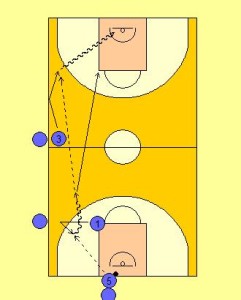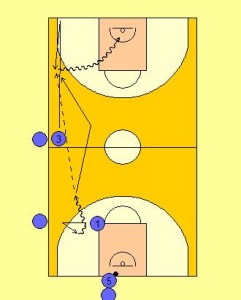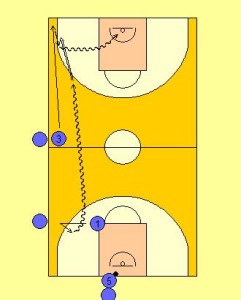Sideline Push Wing Series Drill
The Sideline Push Wing Series Drill looks to provide players with some exposure to the many options available to them when operating down a sideline in transition or fast break situations. Many players often find themselves within a sideline push scenario and are limited to only one option in offense. This is of course not the case, but players do need time to practice and refine these skills until they are able to make reads and react on the run and at game pace. By using the Sideline Push Wing Series Drill to help develop, a wide range of tactical options a team will become harder to guard and score more consistently from broken play or transition.
The Sideline Push Wing Series Drill covers three different scenarios. These are:
- Sideline push pass with receiver driving strong to the to the basket
- Receiver needing to bounce off of baseline to break free of defender before catching pass and drive middle
- Receiver sticks in the long corner because defender denies passing lane so a hand-off is run to free player and create offense
The first scenario to be practiced within the Sideline Push Wing Series Drill is a simple long pass down the sideline and a strong drive initiated to the basket.

This drill starts with three lines of players being positioned on the court. One group is stationed at halfway (Three) and will be the receivers running the sideline throughout the series.
The next group are the players who form the outlet and trail (One).
The third group are players are those who outlet the ball (Five). Once players have fulfilled their role within any line they simply rotate t the next line up the floor.
The Sideline Push Wing Series Drill starts with One (1) creating a good lead as a outlet target. One (1) will move away from the intended catching position extending as far as the three-point line before changing direction to come back and receive a pass from Five (5).
On the flight of the inbound pass Three (3) will start to make a cut down the sideline. To help create a better angle to see the intended pass (and as a standard strategy to be implemented in games) Three (3) should hug the sideline initially before angling slightly back into the court. This will help with the player’s ease of seeing over their shoulder in the direction of the likely pass.
One (1) once catching the pass will take one hard dribble before advancing the ball through a long flat pass to Three (3).
Three (3) once receiving the pass will square up to the basket while ripping the ball from the catching side to the baseline before attacking the basket all in one smooth motion. This action is important in helping the receiver to be able to attack the basket as quickly as possible. So this technique will need to be rehearsed many times before the intended flow and speed is achieved by the majority of players.
Once the pass is made One (1) should cut to the strong side elbow as quickly as possible filling what will be a very valuable receiver spot during games should Three (3) be stopped on the drive and need to find another scoring option. This movement must be a point of focus as players filling the outlet role if not pressured will cut corners and never reach this position for lack of effort. This cannot be accepted, and a high amount of importance needs to be placed upon this role.
The next scenario within the Sideline Push Wing Series Drill focuses on the receiver needing to break free of their defender and additionally flattening out the defence in general through bouncing off the baseline. In this variation Three (3) will move past the initial catching position of the first stage of the drill and continue down to the long corner. From this position Three (3) will then lift or bounce back to the intended catching position at the foul line extended.

This additional time might see One (1) needing to take an additional dribble or so to provide the time necessary for Three (3) to create the space needed. This is not unlike a game and will be helpful in developing One’s (1) poise during a game when looking for this passing opportunity.
When catching the ball Three (3) will be facing towards the backcourt. This will mean that ripping the ball back towards the baseline might result in contact with the defensive player. While driving towards the baseline is still an option in this variation, Three (3) should also be encouraged to catch and attack the middle of the floor. Looking to angle into the driving lane through the high post curling on the dribble all the way to the basket and in so doing denying the defender any opportunity to recover in front of Three (3).
Once the pass is made by One (1) the player should again look to cut towards the strong side elbow. If Three (3) drives towards the baseline, then One (1) will continue to cut into this position. However, if Three (3) drives middle, One (1) should adjust the cut to now fill the space in behind the dribbler towards the foul line extended.
Points of Note
Moving straight down the sideline might not be enough to create the space needed for a catch by Three (3). As the defence becomes more competent, Three(3) might need to also angle in towards the key and then seal the defender before moving back to catch the ball. If the defender is persistent in denying the pass by overplaying Three (3), a backdoor cut might be the best option for a scoring opportunity.
This stage in the Sideline Push Wing Series Drill provides an opportunity for Three (3) to practice driving baseline or middle. Both options should be explored and developed into the offensive mindset of players depending on the position of the defender and what lane is open to the basket.
The final scenario of the Sideline Push Wing Series Drill looks at the possibilities when no pass or backdoor cut is possible by Three (3).

In this scenario Three (3) will hold in the long corner.
One (1) will continue to advance the ball using a dribble down the court. Once reaching the elbow or foul line extended One (1) will then make an aggressive couple of dribbles towards Three (3) looking to set-up for a hand-off.
One (1) should look to angle into the three-point line so once Three (3) collects the ball the player will have a closer distance to the basket from which to shoot or work within. This positioning will also help line up One (1) with Three’s (3) defender and effectively screen the player during the hand-off.
Three (3) will need to collect the ball at pace so some sort of advantage can be created and look to drive at the basket. Depending on Three’s (3) shooting range any number of options can be available.
Depending on the movement of Three (3), One (1) will flare or roll to open space.
Points of Note
One (1) may be able to make a pass to Three (3) at some stage during the set-up and then an on-ball screen can also be utilised from this position.
In this variation, the rest of the defensive players will have likely recovered back to their defensive end of the floor. Have Three (3) practice pull-up jump shots from the edge of the keyway as possible scoring options that are also going to be more game realistic.
Variations
To help build in some complexity to the drill think about adding defence once players become competent with the range of different options. Start by adding just one defender before working up to 3 v 3 situations. The inbounder does not play a part once the ball crosses halfway.






